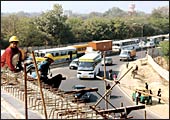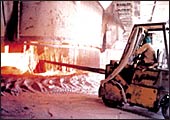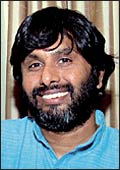 |
 |
| KPCB's Doerr (left) and Sherpalo's
Shriram: Better late than never |
Maybe
you've heard this from a hopeless dotcom investor before: In the
next four to five years, there will be at least two Indian internet
companies that become global players. Your reaction: Yawn. This
time around, you'll be ill advised to ignore the prognosis. For,
making the pronouncement is not a starry-eyed dotcommer, but two
men who are near gods of dotcom investing: Kleiner Perkins Caufield
& Byers' (KPCB) John Doerr, and Sherpalo Ventures' Ram Shriram,
an early investor in Google and who ranks #3 on Forbes' 2006 Midas
List of best venture capitalists (VCs). Doerr, of course, is the
man behind a host of companies such as Compaq (now merged with
hp), Netscape, Sun Microsystems, Amazon, and Google.
To prove they mean it, Doerr and Shriram
are putting their money where their mouth is. They've picked up
a stake in Naukri.com, a leading jobs portal that raked in Rs
8 crore in profits on revenues of Rs 45 crore last year. Besides,
the duo has struck a deal with travel portal Cleartrip.com. The
size of the investment and other details of the two deals have
not been made public yet.
Apparently, Naukri and Cleartrip are the first investments KPCB
has made out of the US. According to Doerr, KPCB never looked
beyond the 30-mile radius of its office in Menlo Park. But now,
Doerr, like Shriram, is quite bullish on consumer-led growth in
the digital space in India. "Unlike China, where growth is
a foreign investment- and a state-led phenomenon, growth in India
is consumer investment- and consumption-led," notes Shriram.
According to Doerr, this is the best time to invest in India because
"the market is now better developed, web is more broad-based,
broadband market is rapidly expanding and there are many young
and smarter entrepreneurs. The business community is positive
about growth in India like never before." But he regrets
the fact that he missed India's software boom.
Both Doerr and Shriram maintain that Web
2.0 in India is about setting up businesses for the local market,
unlike the first wave when players got into the new media business
to mainly outsource. "For the first time ever, there is an
opportunity in India to build companies that would serve the local
consumers and gradually, these can be scaled up to global level,"
says Shriram, who sold his shopbot firm Junglee to Amazon for
$200 million (Rs 840 crore then) before turning a VC. According
to Forbes, he still owns 2.8 million shares in Google, worth more
than $1 billion (Rs 4,500 crore).
What are the new opportunities that they
see in India? "Enterprise solutions for the local community
and not just for outsourcing, product innovations, biotechnology,
energy solutions, new communications and web services are some
of the sectors that are going to grow quite rapidly," says
Doerr. But KPCB and Sherpalo will be more keen on web-oriented
consumer services, energy innovations, mobile solutions and infrastructure
for better communication and connectivity.
Entrepreneurs and venture capital community
in the country think both the Naukri deal and the visit of high-profile
Valley VCs is a significant development. "When John Doerr
and Ram Shriram come to India to explore the market, we can confidently
say that venture capital has finally arrived in the country,"
says Saurabh Srivastava, President, The Indus Entrepreneurs. Expect
fresh ideas to come crawling out of every corner in the country.
-Archna Shukla and Sahad P.V.
Who
Will Drive The Stock Market This Year?
FIIs and large domestic MFs will dominate
in 2006.
 |
| Flush with funds: Definitely something
to smile about |
The
BSE sensex finally crossed the magical 10,000-mark on February
6. And it doesn't look like it's going to run out of gas anytime
soon. The inflows from foreign institutional investors (FIIs)
in January: nearly $1 billion (Rs 4,500 crore). The comparative
figure for the whole of 2005: $10.5 billion (Rs 47,250 crore).
"India is very much in fashion and is looking more and more
like a sustainable trend. The domestic-oriented economy offers
a relatively safe haven and a diversification for international
investors. And FIIs will continue to be the dominant players in
2006," says Dominic Price, Managing Director and Senior Country
Officer, India & Sri Lanka, JP Morgan India, which is setting
up an asset management company in India.
Five others-Lotus India AMC, a joint venture
between the Fullerton Fund Management Group and Sabre Capital,
AIG, Alok Vajpeyi's Dawnay Day and insurance companies Aegon and
Axa Bharti are said to have applied for regulatory clearances
for starting mutual fund operations in India. And Quantum Mutual
Fund has already filed the prospectus for the launch of its first
fund, Quantum Long-term Equity Fund.
India-dedicated hedge funds like the Tricolor
India Opportunities Fund, JF India Capital Fund, Julius Baer Multiopportunities-India
Millennium Fund and Fulcrum DDAV India Opportunity Fund, among
others, have lined up billions of dollars of investments. Incidentally,
there are about 23 India-dedicated hedge funds, of which 14 were
launched in 2005. And unlike in previous years, when players from
the us used to dominate, this time, there are several FIIs from
European and Asia-Pacific countries like Oman, Japan, Denmark,
The Netherlands, Germany, Spain, Hong Kong, Sweden, Scotland,
Australia, Ireland, Singapore, Bahrain, South Korea and Austria
which now want to buy into the India story.
"Inflows can touch $20 billion (Rs 90,000
crore) this year. And I expect the market to deliver returns of
15-20 per cent, though a short-term correction may take place
as it has run up too fast," says Ajay Bagga, CEO, Lotus India
AMC.
Existing mutual funds are also expected to
contribute a fair bit. Market sources say it was primarily Merrill
Lynch, which had collected nearly $750 million (Rs 3,375 crore)
from Japan, that fuelled the Sensex's sharp rise in January. Last
year, funds like Fidelity, Alliance, Deutsche, HSBC, Prudential
and ABN AMRO had mobilised over $5 billion or Rs 22,500 crore
for investments in India and emerging markets. This money is not
completely exhausted and is expected to flow in this year.
Domestic mutual funds are also lining up
big investments. SBI Mutual Fund, HDFC, HSBC, UTI Mutual Fund
and Fidelity have raised around Rs 8,000 crore so far this year.
And more than 20 other funds are set to hit the market in the
near future.
-Mahesh Nayak
Road To Nowhere
The Delhi-Gurgaon Expressway is still a long
way off.
 |
| In a mesh: Hiccups one too many and
the end is nowhere in sight |
It
was expected to be ready and in use by mid-2005. It's already
2006 and there's still no sign of it. Why? The Rs 555-crore, 27.7-
km Delhi-Gurgaon Expressway, also known as National Highway (NH)
8, was awarded to Jaypee DSC in mid-2002. But only two out of
the proposed 11 flyovers along its route are close to completion;
they will be ready by April. The others will be completed only
by February next year. One-third of the expressway passes through
Delhi and the remaining two-third over Haryana. The cost of the
project, meanwhile, has escalated by Rs 200 crore to Rs 755 crore.
The two governments have to cough up this additional sum, but
mobilisation is taking time. Says a government official: "Frequent
changes in the scope of work and the resultant changes in design
have delayed the project. We now expect it to be ready by February
2007."
Part of the land over which the road passes
belongs to the Ministry of Defence. It took more than two years
to acquire this land. Then, as many as 17 agencies, like the Air
Force, Bharat Petroleum Corporation Ltd (BPCL) and GAIL India
Ltd, among others, had to be persuaded to shift their communications
channels, pipelines and other resources to new locations. The
persuasion continues; officials have asked for one more month-as
they did six months ago. And work on the 32-lane toll plaza at
the Delhi-Haryana border has been held up as the land on which
it will come up, belonging to the Haryana government, has not
yet been transferred to the National Highways Authority of India,
which is the nodal agency for the project. The issue has been
pending for three years.
Officials say the road-eight-laned for 22
km and six-laned over the remaining 5.7 km-which was expected
to provide relief to the 1.15 lakh vehicles which travel between
Delhi and Gurgaon every day, will be traffic-worthy and tollable
by December 2006, but some additional work will take another seven
months. But by then, the traffic density will almost certainly
rise further. Can the expressway handle the additional load? Or
will another one be required? Jaypee DSC officials were unavailable
for comment. One can only hope for the best.
-Kumarkaushalam
Cement Consolidates
 |
| Cementing deals: Very much hot |
Is
the cement industry going to witness some major consolidation?
Or is Holcim's Rs 2,142-crore acquisition of a 14.8 per cent stake
in Gujarat Ambuja Cements Limited (GACL) from its promoters, the
Sekhsarias and the Neotias, a one-off event? Says Munesh Khanna,
Managing Director, Enam Financial Consultants: "Consolidation
is here to stay; and this indicates a very high level of maturity."
The GACL-ACC combine and the Aditya Birla Group's Grasim are now
running neck and neck, with capacities of about 33 and 31 million
tonnes, respectively. Grasim had earlier acquired the cement business
of L&T.
"The cement industry is growing at 11
per cent per annum," says Ambareesh Baliga, VP, Karvy Stockbroking.
"The infrastructure boom is leading to some serious activity
in upstream sectors like cement," he adds. Capacity is crucial
in such a scenario, and players with large capacities and pan-Indian
footprints will have a clear advantage over regional ones.
The price at which the Holcim-GACL deal has
been struck ($212 or Rs 9,540 per tonne) has set a new benchmark
and is at least 20 per cent higher than what conventional wisdom
would have accepted. At this price, several small and regional
players may be tempted to cash out. It's a win-win situation-the
big boys get additional capacities and the sellers receive a price
that is much higher than what they would have expected.
Just the right kind of atmosphere for another
round of consolidation.
-Krishna Gopalan
CEO's Guide
To The New Cabinet
An introduction to the new economic ministers
in the UPA government.
On
January 29, prime minister Manmohan Singh carried out the first
major expansion-cum-reshuffle of his 20-month-old United Progressive
Alliance government, inducting as many as 22 ministers, of them
10 Cabinet ministers. Here's a look at some of the new faces in
charge of economic ministries. (With this expansion, there are
79 Cabinet ministers in the UPA government-the largest ever Cabinet.)
 Shibu
Soren, 62, Minister of Coal: Twice dropped from the Cabinet
following arrest warrants for his alleged involvement in the killing
of 11 people in Bihar 20 years ago, Soren lands his preferred
portfolio. Shibu
Soren, 62, Minister of Coal: Twice dropped from the Cabinet
following arrest warrants for his alleged involvement in the killing
of 11 people in Bihar 20 years ago, Soren lands his preferred
portfolio.
 T.
Subbarami Reddy, 62, MoS, Ministry of Mines: A versatile man
with diverse interests from films to spirituality, Reddy is also
a businessman, besides being the chairman of Tirumala Tirupathi
Devasthanam (Tirupati temple). T.
Subbarami Reddy, 62, MoS, Ministry of Mines: A versatile man
with diverse interests from films to spirituality, Reddy is also
a businessman, besides being the chairman of Tirumala Tirupathi
Devasthanam (Tirupati temple).
 Pavan
Kumar Bansal, 57, MoS, Ministry of Finance: In December 2005,
Bansal had resigned as Chairman of the Member of Parliament Local
Area Development Scheme, following allegations of diversion of
his constituency development fund. Pavan
Kumar Bansal, 57, MoS, Ministry of Finance: In December 2005,
Bansal had resigned as Chairman of the Member of Parliament Local
Area Development Scheme, following allegations of diversion of
his constituency development fund.
 Akhilesh
Das, 43, MoS, Ministry of Steel: Businessman and international
badminton player, Das also owns a multi-billion rupee education
empire that includes engineering colleges, dental colleges and
management schools in Uttar Pradesh. Akhilesh
Das, 43, MoS, Ministry of Steel: Businessman and international
badminton player, Das also owns a multi-billion rupee education
empire that includes engineering colleges, dental colleges and
management schools in Uttar Pradesh.
 Dinsha
J. Patel, 68, MoS, Ministry of Petroleum and Natural Gas: Businessman
and agriculturist, Patel is also a social and political activist.
He's been on various committees, including those of the Railways
and Heavy Industries. Dinsha
J. Patel, 68, MoS, Ministry of Petroleum and Natural Gas: Businessman
and agriculturist, Patel is also a social and political activist.
He's been on various committees, including those of the Railways
and Heavy Industries.
 Murli
Deora, 69, Minister of Petroleum and Natural Gas: A well-known
industrialist and Rajya Sabha member, Deora is known to be friends
with the movers and shakers of not just India Inc., but also the
American establishment. Murli
Deora, 69, Minister of Petroleum and Natural Gas: A well-known
industrialist and Rajya Sabha member, Deora is known to be friends
with the movers and shakers of not just India Inc., but also the
American establishment.
 Jairam
Ramesh, 51, MoS, Ministry of Commerce and Industry: A well-known
economist and author, Ramesh played a key role in drafting the
UPA manifesto, besides crafting Congress' win in the national
elections. Jairam
Ramesh, 51, MoS, Ministry of Commerce and Industry: A well-known
economist and author, Ramesh played a key role in drafting the
UPA manifesto, besides crafting Congress' win in the national
elections.
 Sushil
Kumar Shinde, 64, Minister of Power: A Congress loyalist,
Shinde may be unwilling to accept the free power business and
thus, continue with the reforms in the power sector. Sushil
Kumar Shinde, 64, Minister of Power: A Congress loyalist,
Shinde may be unwilling to accept the free power business and
thus, continue with the reforms in the power sector.
-Ashish Gupta
SELF
WORTH:
Kishore Biyani
Retail's Rule-maker
Why Pantaloon's Kishore Biyani has a finger
on the pulse of Bargain Nation.
 |
| Pantaloon's Biyani: Eyerybody
loves a good bargain |
Modern
retail is supposed to be complicated business. And we are not
just talking about managing a supply chain involving hundreds
of suppliers or managing store inventory running into thousands
of SKUs (stock-keeping units). Retail is supposed to be complicated
for one simple reason: You can never really tell what your customers
want. That's why giant retailers like Wal-Mart and Target spend
millions of dollars running sophisticated computer systems that
not just track what gets and doesn't get sold, but the time, place
and identity of the buyer. That way, retailers get to push their
stocks faster and better.
By that measure, India's biggest retailer
Kishore Biyani of Pantaloon Retail doesn't run a very sophisticated
shop. In fact, if you've ever shopped at any of his Big Bazaar
stores (and especially on a weekend) you'll know that checkouts
take forever. Yet, nobody can deny one thing: Biyani knows, better
than any other retailer in the country, just what his customers
want. His Big Bazaar chain of stores have been a big hit with
hoi polloi, helping Biyani grow it from Rs 136.5 crore in revenues
in 2000 to (a projected) Rs 2,000 crore for 2005-06.
On January 26, Biyani once again demonstrated
his special insight into the average consumer psyche, when he
launched a Sabse sasta din (roughly, Day of lowest price), offering
up to 80 per cent discount across product categories. What ensued
was a virtual stampede across Big Bazaar stores in the country.
In Western Mumbai, for instance, it is estimated more than 20,000
people turned up at one of the outlets, compared to a usual crowd
size of barely 250 at any given point in time. In Bangalore's
Banashankari and Koramangala outlets, police forces had to be
deployed because the rush of shoppers had become uncontrollable.
Even in Gurgaon, the store was closed mid-way through the day
because over 30,000 shoppers turned up (typically, there are about
20,000 people who turn up in total through the day. In this case,
there were more than 30,000 at one time).
Biyani admits that the response exceeded
his wildest imagination, but he thinks he knows why. "India
is split into two kinds of possible consumers: One is those who
can afford to spend and the other is made up of those who serve
the spenders. This time around, we got in those who serve the
spenders." In one sense, the emergence of the classic Indian
middle (or lower?) class came to the fore that day, when it seemed
just natural to buy goods at throwaway prices. Products like mobile
phones and furniture, points out Biyani, sold like "hot cakes".
The lessons for Biyani, who has spent time studying consumption
habits in slums, are straightforward. For Pantaloon, he says,
the world has been divided between "before January 26 and
after January 26". He might well be speaking of Retail India.
-Krishna Gopalan
Rediff Catches A Lucky Wind
 |
| Balakrishnan: Rising stock |
What does it take to
get your market cap jump by 35 per cent on the NASDAQ? a matching
projection in earnings growth? Nah. If you are Rediff, all it
takes is a mention on Jim Cramer's highly influential show on
CNBC, Mad Money, where he said the zero-debt pure play could be
a good investment. That made the loss-making portal's (2005 revenues:
$26 million or Rs 117 crore) market cap soar over a third to $580
million or Rs 2,610 crore. What does Rediff promoter Ajit Balakrishnan
have to say? "I am happy, but believe it or not, I don't
track my stock movement." Maybe now he will.
-Sahad P.V.
'India Is Key For IBM'
 |
| IBM's Rometty: India important both
as a market and as a talent base |
Virginia
'Ginni' Rometty, 48, is managing
partner of IBM Business Consulting, the largest unit of IBM's
Global Services (IGs), which brought in more than half of IBM's
$91.1 billion (Rs 409,950 crore) revenues in 2005. Rometty played
a key role in IBM's acquisition of Daksh in the Indian marketplace.
She met BT's Venkatesha Babu in
Bangalore recently and outlined IGs' strategy in India and discussed
what separates Big Blue from its competitors. Excerpts:
Are you satisfied with IBM's performance
in India?
India has been very good for IBM, both as
a market and as a resource base. Today, we have over 38,000 people
working for IGs. In the domestic market, we have grown 60 per
cent over the last year (IBM does not announce country-specific
numbers). India is the global Linux hub for IBM. Our oil, gas
and energy practice here is one of the largest we have anywhere
and our R&D labs are driving key innovation strategies. So,
India is very important both as a market and as a talent base.
You acquired Daksh and NetSol (Network
Solutions). You personally played a key role in the Daksh acquisition.
Any more in the offing?
The two acquisitions are very different from
each other. Daksh was a part of our quest for better global resources,
while the NetSol deal was primarily aimed at the domestic market.
And if we come across some company that can add value to our offerings
or help us provide a high-value service or get into a new space,
we will definitely look at it.
Indian companies are trying to move up
the value chain by emphasising and enhancing their consulting
business and hiring rainmakers. Where do you see IBM vis-a vis
Tier-I Indian players like TCS, Infosys or an Wipro?
We're completely different. You described
it right; they're hiring 'rainmakers', that is salesmen. They
have to offshore the bulk of their work here. IBM is present in
180 countries. We will do the same work where we have the competencies.
Ours is an asset-based strategy compared to the offshore strategy
of Indian players. We have always led the way in creating solutions
in the services' space driven by innovation.
Old Lane, New Road
 |
| Ramakrishnan: On road less travelled |
Lounging on a
sofa, guru Ramakrishnan, 41, is reciting fluently from Hindu scriptures,
which he swears keeps him sane in a mad world. One suspects he
will need all the help he can get as he prepares, with colleagues
Vikram Pandit and John Havens, to plunge into the maelstrom that
is infrastructure financing in India. These three former Morgan
Stanley executives have floated Old Lane, a private equity fund
that proposes to invest $500 million (Rs 2,250 crore) in Indian
infrastructure projects. And it's not the usual roads-techparks-ports
they're gunning for. "We'll position ourselves somewhere
between portfolio investment and foreign direct investment,"
says Ramakrishnan. On his radar are projects ranging from financial
market architecture and energy to healthcare R&D and telecom.
The money will be locked in for 10 years, giving ample time for
projects to blossom. Ramakrishnan has already signed three MoUs
with leading players in infrastructure, real estate and engineering.
The fund, to be activated from April 2007, will take two to four
years to be fully deployed, and Ramakrishnan expects to invest
an average $15 million (Rs 67.5 crore) per project. And given
the global liquidity boom and the growing interest in India, Old
Lane, one learns, might actually end up mobilising $750 million
(Rs 3,375 crore). The new road just got bigger.
-Vaishna Roy
|









 Shibu
Soren, 62, Minister of Coal: Twice dropped from the Cabinet
following arrest warrants for his alleged involvement in the killing
of 11 people in Bihar 20 years ago, Soren lands his preferred
portfolio.
Shibu
Soren, 62, Minister of Coal: Twice dropped from the Cabinet
following arrest warrants for his alleged involvement in the killing
of 11 people in Bihar 20 years ago, Soren lands his preferred
portfolio. T.
Subbarami Reddy, 62, MoS, Ministry of Mines: A versatile man
with diverse interests from films to spirituality, Reddy is also
a businessman, besides being the chairman of Tirumala Tirupathi
Devasthanam (Tirupati temple).
T.
Subbarami Reddy, 62, MoS, Ministry of Mines: A versatile man
with diverse interests from films to spirituality, Reddy is also
a businessman, besides being the chairman of Tirumala Tirupathi
Devasthanam (Tirupati temple).  Pavan
Kumar Bansal, 57, MoS, Ministry of Finance: In December 2005,
Bansal had resigned as Chairman of the Member of Parliament Local
Area Development Scheme, following allegations of diversion of
his constituency development fund.
Pavan
Kumar Bansal, 57, MoS, Ministry of Finance: In December 2005,
Bansal had resigned as Chairman of the Member of Parliament Local
Area Development Scheme, following allegations of diversion of
his constituency development fund. Akhilesh
Das, 43, MoS, Ministry of Steel: Businessman and international
badminton player, Das also owns a multi-billion rupee education
empire that includes engineering colleges, dental colleges and
management schools in Uttar Pradesh.
Akhilesh
Das, 43, MoS, Ministry of Steel: Businessman and international
badminton player, Das also owns a multi-billion rupee education
empire that includes engineering colleges, dental colleges and
management schools in Uttar Pradesh. Dinsha
J. Patel, 68, MoS, Ministry of Petroleum and Natural Gas: Businessman
and agriculturist, Patel is also a social and political activist.
He's been on various committees, including those of the Railways
and Heavy Industries.
Dinsha
J. Patel, 68, MoS, Ministry of Petroleum and Natural Gas: Businessman
and agriculturist, Patel is also a social and political activist.
He's been on various committees, including those of the Railways
and Heavy Industries.  Murli
Deora, 69, Minister of Petroleum and Natural Gas: A well-known
industrialist and Rajya Sabha member, Deora is known to be friends
with the movers and shakers of not just India Inc., but also the
American establishment.
Murli
Deora, 69, Minister of Petroleum and Natural Gas: A well-known
industrialist and Rajya Sabha member, Deora is known to be friends
with the movers and shakers of not just India Inc., but also the
American establishment. Jairam
Ramesh, 51, MoS, Ministry of Commerce and Industry: A well-known
economist and author, Ramesh played a key role in drafting the
UPA manifesto, besides crafting Congress' win in the national
elections.
Jairam
Ramesh, 51, MoS, Ministry of Commerce and Industry: A well-known
economist and author, Ramesh played a key role in drafting the
UPA manifesto, besides crafting Congress' win in the national
elections. Sushil
Kumar Shinde, 64, Minister of Power: A Congress loyalist,
Shinde may be unwilling to accept the free power business and
thus, continue with the reforms in the power sector.
Sushil
Kumar Shinde, 64, Minister of Power: A Congress loyalist,
Shinde may be unwilling to accept the free power business and
thus, continue with the reforms in the power sector.


